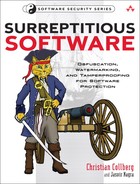Book Description
“This book gives thorough, scholarly coverage of an area of growing importance in computer security and is a ‘must have’ for every researcher, student, and practicing professional in software protection.”
—Mikhail Atallah, Distinguished Professor of Computer Science at Purdue University
Theory, Techniques, and Tools for Fighting Software Piracy, Tampering, and Malicious Reverse Engineering
The last decade has seen significant progress in the development of techniques for resisting software piracy and tampering. These techniques are indispensable for software developers seeking to protect vital intellectual property. Surreptitious Software is the first authoritative, comprehensive resource for researchers, developers, and students who want to understand these approaches, the level of security they afford, and the performance penalty they incur.
Christian Collberg and Jasvir Nagra bring together techniques drawn from related areas of computer science, including cryptography, steganography, watermarking, software metrics, reverse engineering, and compiler optimization. Using extensive sample code, they show readers how to implement protection schemes ranging from code obfuscation and software fingerprinting to tamperproofing and birthmarking, and discuss the theoretical and practical limitations of these techniques.
Coverage includes
Mastering techniques that both attackers and defenders use to analyze programs
Using code obfuscation to make software harder to analyze and understand
Fingerprinting software to identify its author and to trace software pirates
Tamperproofing software using guards that detect and respond to illegal modifications of code and data
Strengthening content protection through dynamic watermarking and dynamic obfuscation
Detecting code theft via software similarity analysis and birthmarking algorithms
Using hardware techniques to defend software and media against piracy and tampering
Detecting software tampering in distributed system
Understanding the theoretical limits of code obfuscation
Table of Contents
- Copyright
- Addison-Wesley Software Security Series
- Preface
- About the Authors
- Acknowledgments
- 1. What Is Surreptitious Software?
- 1.1. Setting the Scene
- 1.2. Attack and Defense
- 1.3. Program Analysis
- 1.4. Code Obfuscation
- 1.5. Tamperproofing
- 1.6. Software Watermarking
- 1.7. Software Similarity
- 1.8. Hardware-Based Protection Techniques
- 1.9. Discussion
- 1.10. Notation
- 2. Methods of Attack and Defense
- 2.1. Attack Strategies
- 2.1.1. A Prototypical Cracking Target
- 2.1.2. What’s the Adversary’s Motivation?
- 2.1.3. What Does the Adversary Get to Crack?
- 2.1.4. What’s the Adversary’s Attack Methodology?
- 2.1.5. What Tools Does the Adversary Use?
- 2.1.6. What Techniques Does the Adversary Use?
- 2.1.6.1. Learning About the Executable
- 2.1.6.2. Breaking on Library Functions
- 2.1.6.3. Static Pattern Matching
- 2.1.6.4. Watching Memory
- 2.1.6.5. Recovering Internal Data
- 2.1.6.6. Tampering with the Environment
- 2.1.6.7. Dynamic Pattern Matching
- 2.1.6.8. Differential Attacks
- 2.1.6.9. Recovering Algorithms Through Decompilation
- 2.1.7. Discussion
- 2.2. Defense Strategies
- 2.2.1. Notation
- 2.2.2. The cover Primitive
- 2.2.3. The duplicate Primitive
- 2.2.4. The split and merge Primitives
- 2.2.5. The reorder Primitive
- 2.2.6. The map Primitive
- 2.2.7. The indirect Primitive
- 2.2.8. The mimic Primitive
- 2.2.9. The advertise Primitive
- 2.2.10. The detect-respond Primitive
- 2.2.11. The dynamic Primitive
- 2.2.12. Discussion
- 2.3. Discussion
- 2.1. Attack Strategies
- 3. Program Analysis
- 4. Code Obfuscation
- 4.1. Semantics-Preserving Obfuscating Transformations
- 4.2. Definitions
- 4.3. Complicating Control Flow
- 4.4. Opaque Predicates
- 4.5. Data Encodings
- 4.6. Breaking Abstractions
- 4.7. Discussion
- 5. Obfuscation Theory
- 5.1. Definitions
- 5.2. Provably Secure Obfuscation: Possible or Impossible?
- 5.3. Provably Secure Obfuscation: It’s Possible (Sometimes)!
- 5.4. Provably Secure Obfuscation: It’s Impossible (Sometimes)!
- 5.5. Provably Secure Obfuscation: Can It Be Saved?
- 5.6. Discussion
- 6. Dynamic Obfuscation
- 7. Software Tamperproofing
- 7.1. Definitions
- 7.2. Introspection
- 7.4. State Inspection
- 7.5. Remote Tamperproofing
- 7.6. Discussion
- 8. Software Watermarking
- 8.1. History and Applications
- 8.2. Watermarking Software
- 8.3. Definitions
- 8.4. Watermarking by Permutation
- 8.5. Tamperproofing Watermarks
- 8.6. Improving Resilience
- 8.7. Improving Stealth
- 8.8. Steganographic Embeddings
- 8.9. Splitting Watermark Integers
- 8.10. Graph Codecs
- 8.11. Discussion
- 9. Dynamic Watermarking
- 9.1. Algorithm WMCT: Exploiting Aliasing
- 9.2. Algorithm WMNT: Exploiting Parallelism
- 9.3. Algorithm WMCCDKHLSpaths: Expanding Execution Paths
- 9.4. Algorithm WMCCDKHLSbf: Tamperproofing Execution Paths
- 9.5. Discussion
- 10. Software Similarity Analysis
- 11. Hardware for Protecting Software
- 11.1. Anti-Piracy by Physical Distribution
- 11.2. Authenticated Boot Using a Trusted Platform Module
- 11.3. Encrypted Execution
- 11.4. Attacks on Tamperproof Devices
- 11.5. Discussion
- Bibliography
